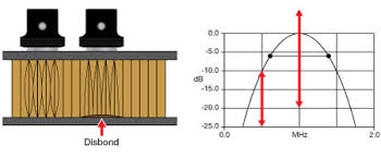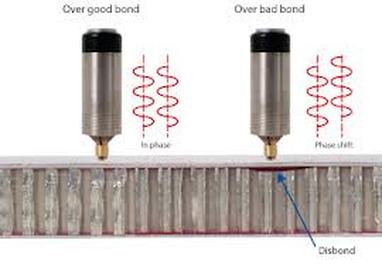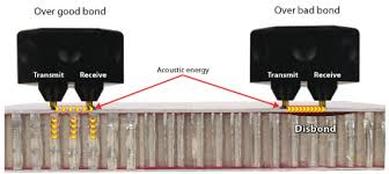Bond Testing
There are three different ways of bond testing which all rely on the stiffness of the material under test. These are Resonance, Mechanical Impedance Analysis
(MIA) and Pitch-Catch. Each different method has their strengths and weaknesses during their applications so in practise a combination of all are often used.
(MIA) and Pitch-Catch. Each different method has their strengths and weaknesses during their applications so in practise a combination of all are often used.

Resonance
Where the probe is over a good area it is dampened and the amplitude and phase are as position A. Where there is a disbond present, the skin is less stiff and so the amplitude and phase of the probe signal is changed, as per position B.
A B A B
Where the probe is over a good area it is dampened and the amplitude and phase are as position A. Where there is a disbond present, the skin is less stiff and so the amplitude and phase of the probe signal is changed, as per position B.
A B A B

Mechanical Impedance Analysis - MIA
This technique uses a single point of contact and is particularly useful in the detection and
sizing of the bond/disbond location.
Mechanical Impedance Analysis (MIA) has for many years provided sound technology to
aerospace and composite bond testing. Being able to analyse response signals from materials in both amplitude and phase at either single or dual frequencies is many times more sensitive than ‘tap testing’ and more rapid.
This technique uses a single point of contact and is particularly useful in the detection and
sizing of the bond/disbond location.
Mechanical Impedance Analysis (MIA) has for many years provided sound technology to
aerospace and composite bond testing. Being able to analyse response signals from materials in both amplitude and phase at either single or dual frequencies is many times more sensitive than ‘tap testing’ and more rapid.

Pitch-Catch
A dual tip probe is placed onto the surface of a component and a short tone burst or pulse is
sent into the material from one probe tip and received by the other.

